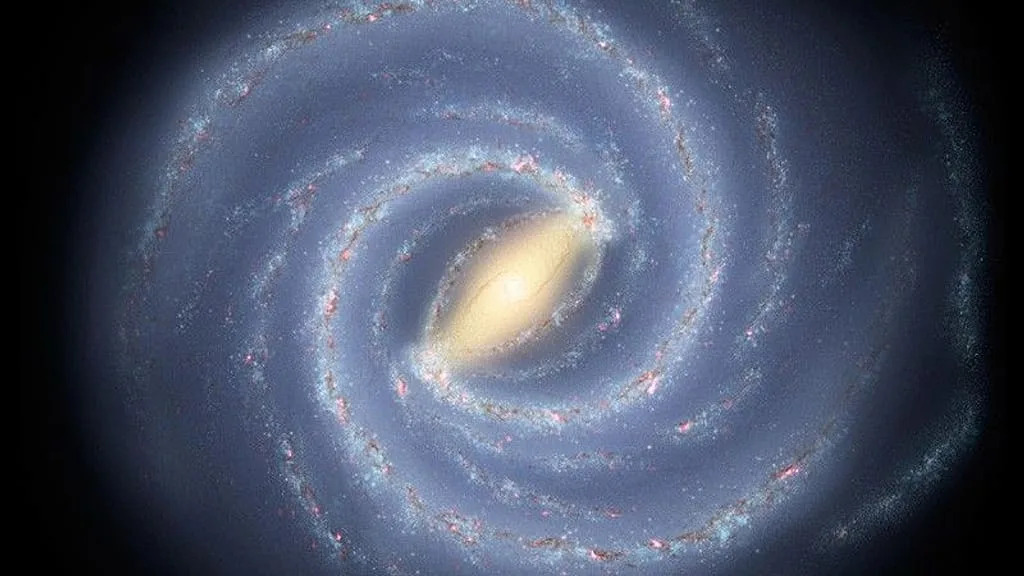Science
Scientists Unveil Detailed Milky Way Model Using AI Techniques

A groundbreaking simulation has provided scientists with the most detailed model of the Milky Way galaxy to date. This innovative project, led by researcher Keiya Hirashima at the RIKEN Center for Interdisciplinary Theoretical and Mathematical Sciences (iTHEMS) in Japan, tracks over 100 billion individual stars over a span of 10,000 years. The new approach offers an unprecedented resolution, illuminating the complexities of galactic evolution that astrophysicists have sought for decades.
Previously, the most advanced simulations aggregated stars into larger groups, obscuring the intricate physics that govern how galaxies develop and transform. The latest model marks a significant departure from this method. By integrating deep learning with traditional physics-based modelling, the research team achieved a simulation that runs 100 times faster than earlier techniques, while incorporating 100 times more stars.
Overcoming Challenges in Galactic Simulation
To comprehend the formation and ongoing evolution of the Milky Way, scientists require models that accurately represent both the extensive spiral structures and the behavior of individual stars and supernovae. The physical processes involved—gravity, gas dynamics, chemical enrichment, and explosive stellar deaths—occur across vastly different timescales. This complexity has made it challenging to capture rapid events like supernova explosions, often requiring simulations to progress in tiny increments. Consequently, modelling a billion years of galactic history could take decades, posing a formidable computational challenge.
Hirashima’s team addressed this issue by introducing a deep learning surrogate model trained on high-resolution simulations of supernova behavior. This AI model learned to predict gas dispersion in the 100,000 years following a supernova explosion, allowing the primary simulation to advance more rapidly while maintaining the detail of individual events. The effectiveness of this method was validated using data from Japan’s Fugaku supercomputer and the University of Tokyo’s Miyabi system.
The outcome is a comprehensive Milky Way simulation capable of achieving true individual-star resolution. The model can simulate one million years of galactic evolution in just 2.78 hours, meaning a billion years could now be modeled in around 115 days—a dramatic reduction from the previous estimate of 36 years.
Implications Beyond Astronomy
While this achievement represents a major milestone in astrophysics, its implications extend far beyond the realm of space science. The research paper indicates that similar methodologies can be applied to simulations of cosmic large-scale structure formation and black hole accretion. Furthermore, the hybrid AI-physics methods developed could also enhance simulations in other fields such as weather, climate, and turbulence.
“I believe that integrating AI with high-performance computing marks a fundamental shift in how we tackle multi-scale, multi-physics problems across the computational sciences,” stated Hirashima. He emphasized that this breakthrough demonstrates that AI-accelerated simulations can evolve beyond simple pattern recognition, emerging as genuine tools for scientific discovery. This technology could help trace the origins of the elements that contributed to the formation of life itself within our galaxy.
Looking ahead, the team plans to scale this technique further and explore its potential applications in Earth system modelling, promising exciting advancements in various scientific fields.
-

 Education2 months ago
Education2 months agoBrandon University’s Failed $5 Million Project Sparks Oversight Review
-

 Lifestyle3 months ago
Lifestyle3 months agoWinnipeg Celebrates Culinary Creativity During Le Burger Week 2025
-

 Science3 months ago
Science3 months agoMicrosoft Confirms U.S. Law Overrules Canadian Data Sovereignty
-

 Health3 months ago
Health3 months agoMontreal’s Groupe Marcelle Leads Canadian Cosmetic Industry Growth
-

 Science3 months ago
Science3 months agoTech Innovator Amandipp Singh Transforms Hiring for Disabled
-

 Technology3 months ago
Technology3 months agoDragon Ball: Sparking! Zero Launching on Switch and Switch 2 This November
-

 Education3 months ago
Education3 months agoRed River College Launches New Programs to Address Industry Needs
-

 Technology3 months ago
Technology3 months agoGoogle Pixel 10 Pro Fold Specs Unveiled Ahead of Launch
-

 Technology1 month ago
Technology1 month agoDiscord Faces Serious Security Breach Affecting Millions
-

 Business2 months ago
Business2 months agoRocket Lab Reports Strong Q2 2025 Revenue Growth and Future Plans
-

 Science3 months ago
Science3 months agoChina’s Wukong Spacesuit Sets New Standard for AI in Space
-

 Education3 months ago
Education3 months agoAlberta Teachers’ Strike: Potential Impacts on Students and Families
-

 Technology3 months ago
Technology3 months agoWorld of Warcraft Players Buzz Over 19-Quest Bee Challenge
-

 Business3 months ago
Business3 months agoNew Estimates Reveal ChatGPT-5 Energy Use Could Soar
-

 Business3 months ago
Business3 months agoDawson City Residents Rally Around Buy Canadian Movement
-

 Technology1 month ago
Technology1 month agoHuawei MatePad 12X Redefines Tablet Experience for Professionals
-

 Education3 months ago
Education3 months agoNew SĆIȺNEW̱ SṮEȽIṮḴEȽ Elementary Opens in Langford for 2025/2026 Year
-

 Technology3 months ago
Technology3 months agoFuture Entertainment Launches DDoD with Gameplay Trailer Showcase
-

 Business3 months ago
Business3 months agoBNA Brewing to Open New Bowling Alley in Downtown Penticton
-

 Technology3 months ago
Technology3 months agoInnovative 140W GaN Travel Adapter Combines Power and Convenience
-

 Technology3 months ago
Technology3 months agoGlobal Launch of Ragnarok M: Classic Set for September 3, 2025
-

 Science3 months ago
Science3 months agoXi Labs Innovates with New AI Operating System Set for 2025 Launch
-

 Technology3 months ago
Technology3 months agoNew IDR01 Smart Ring Offers Advanced Sports Tracking for $169
-

 Technology3 months ago
Technology3 months agoDiscover the Relaxing Charm of Tiny Bookshop: A Cozy Gaming Escape










